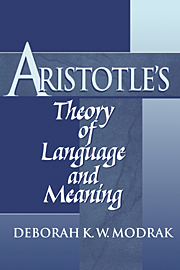8 - Abstract Thought and Meaning
Published online by Cambridge University Press: 16 November 2009
Summary
As a mode of sensory representation, phantasia is well placed to secure the reference of a common noun such as cat. An image derived from the perception of one cat resembles other cats. Aristotle's theory of meaning interpreted in light of his conception of phantasia faces several challenges, as we saw at the end of Chapter 7. The extension of his theory of meaning thus interpreted to include scientific definition raises additional questions. At best the image of a cat seems to convey minimal information about the essence of a cat, and so it appears to have little relevance for the logos that is captured in the real definition and is constitutive of knowledge. The image, moreover, presents as salient characteristics features that may be unique to the individual cat(s) perceived, yet ex hypothesi the mind derives the meaning of the generic term ‘cat’ from images of individual cats. How the mind grasps the essence remains a mystery, as does how the mind grasps the meanings of the terms that are common names of macroscopic objects.
Aristotle's answer to these puzzles, if he has one, must be found in his conception of thought. The challenge he faces is to give an account that allows phantasia to play a crucial role in determining reference while avoiding the pitfalls sketched above. Were he to envisage thinking in a way that forced sensory representation to the sidelines by treating it as little more than a backdrop of moving imagery, sensory representation would become irrelevant or dispensable for the activity of thinking.
- Type
- Chapter
- Information
- Aristotle's Theory of Language and Meaning , pp. 244 - 264Publisher: Cambridge University PressPrint publication year: 2000



